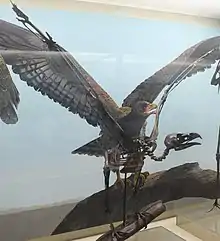Neogyps
Neogyps is an extinct monotypic genus of Old World vulture. Despite being an "Old World" vulture taxonomically, it was native to the New World, with its fossils having been found in western North America, including in the La Brea Tar Pits of southern California, dating to the Late Pleistocene.[1][2] Several morphological characters suggest that Neogyps is closely related to the subfamily Gypaetinae.[3]
| Neogyps Temporal range: Pleistocene | |
|---|---|
 | |
| Neogyps errans fossil | |
| Scientific classification | |
| Domain: | Eukaryota |
| Kingdom: | Animalia |
| Phylum: | Chordata |
| Clade: | Dinosauria |
| Class: | Aves |
| Order: | Accipitriformes |
| Family: | Accipitridae |
| Subfamily: | Gypaetinae |
| Genus: | †Neogyps Miller, 1916 |
| Species: | †N. errans |
| Binomial name | |
| †Neogyps errans Miller, 1916 | |
References
- Zhang, Z.; Huang, Y.; James, H. F.; Hou, L. (2012). "Two Old World vultures from the middle Pleistocene of northeastern China and their implications for interspecific competition and biogeography of Aegypiinae". Journal of Vertebrate Paleontology. 32: 117–124. doi:10.1080/02724634.2012.624146. S2CID 85765495.
- Sánchez-Marco, Antonio (2022-03-20). "Two new Gypaetinae (Accipitridae, Aves) from the late Miocene of Spain". Historical Biology. 34 (8): 1534–1543. doi:10.1080/08912963.2022.2053117. ISSN 0891-2963. S2CID 247605500.
- Li, Zhiheng; Clarke, Julia A.; Zhou, Zhonghe; Deng, Tao (October 2016). "A new Old World vulture from the late Miocene of China sheds light on Neogene shifts in the past diversity and distribution of the Gypaetinae". The Auk. 133 (4): 615–625. doi:10.1642/AUK-15-240.1. ISSN 0004-8038. S2CID 88747285.
This article is issued from Wikipedia. The text is licensed under Creative Commons - Attribution - Sharealike. Additional terms may apply for the media files.